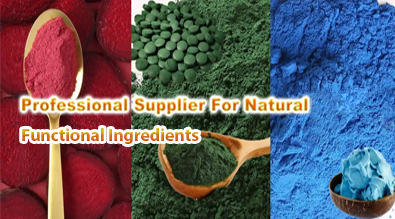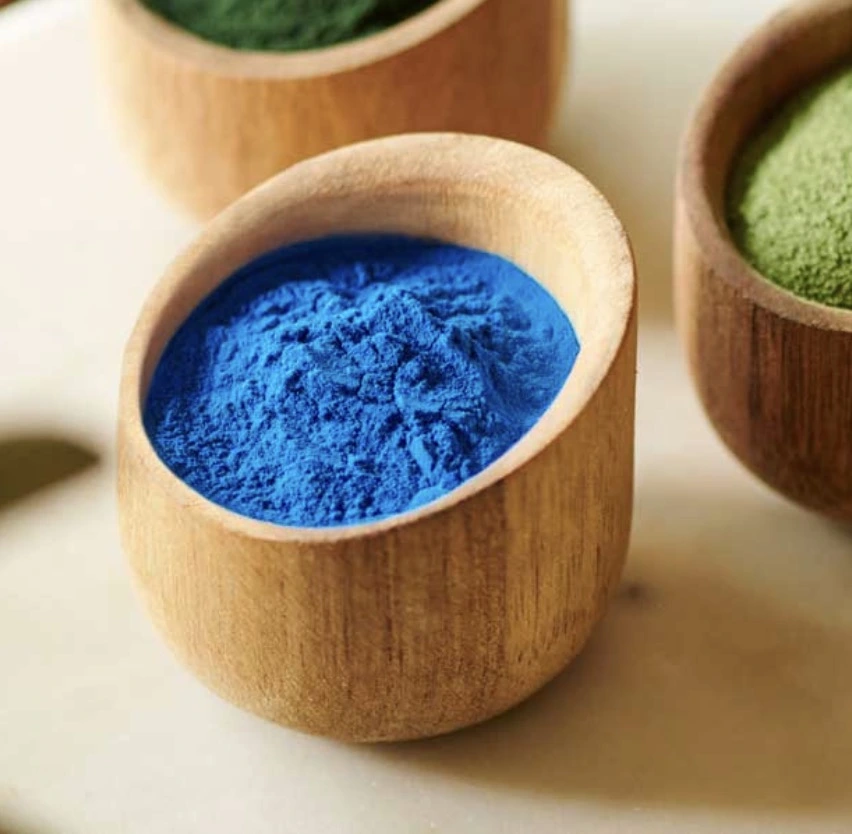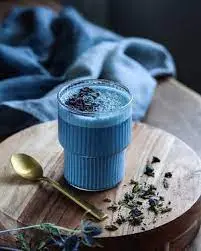How does spirulina reduce fish feed costs in aquaculture?
In the ever-evolving world of aquaculture, finding cost-effective and sustainable feed solutions is paramount. Blue spirulina powder has emerged as a game-changing ingredient that not only enhances fish nutrition but also significantly reduces feed costs. This article explores the multifaceted benefits of blue spirulina powder in aquaculture and its potential to revolutionize fish farming practices.

Blue Spirulina Powder Benefits in Fish Nutrition
Nutrient-Rich Profile
Blue spirulina powder, extracted from Arthrospira platensis, is a nutrient-dense superfood perfectly suited for use in fish feed. It offers an exceptional combination of high-quality proteins, essential amino acids, vitamins, minerals, and powerful antioxidants. With a protein content ranging from 60% to 70%, blue spirulina surpasses many conventional protein sources commonly used in aquaculture. Its rich nutritional composition supports healthy growth, enhances vitality, and contributes to the overall well-being of fish, making it an excellent natural ingredient for sustainable aquafeed formulations.
Enhanced Growth and Development
Adding blue spirulina powder to fish feed has been shown to significantly enhance growth and development in aquaculture species. Its highly digestible proteins and balanced amino acid profile support efficient nutrient utilization, leading to faster growth rates and improved feed conversion ratios. Research indicates that fish consuming spirulina-enriched diets experience greater weight gain, increased muscle mass, and improved overall health. These benefits make blue spirulina a valuable functional ingredient for optimizing fish performance and promoting sustainable aquaculture practices.
Improved Immune Function
A key advantage of blue spirulina powder is its powerful immune-boosting capability. Rich in antioxidants—especially phycocyanin—it helps fortify the fish’s immune system, enhancing resilience against diseases and environmental stressors. This strengthened immunity reduces mortality rates and minimizes dependence on antibiotics, promoting healthier and more sustainable farming practices. As a result, incorporating blue spirulina into fish feed not only supports animal welfare but also leads to significant cost savings and improved efficiency in aquaculture production.

Reducing Aquaculture Feed Costs with Blue Spirulina
Partial Replacement of Expensive Protein Sources
Conventional aquaculture feeds frequently depend on costly protein sources like fishmeal and soybean meal. Blue spirulina powder provides an economical alternative by partially substituting these expensive ingredients. With its high protein content and well-balanced amino acid profile, it enables substantial reductions in the use of pricier proteins while maintaining the feed’s nutritional quality. Incorporating blue spirulina not only helps lower production costs but also supports sustainable aquaculture practices by reducing reliance on traditional protein sources, making it an effective and efficient addition to fish diets.
Improved Feed Conversion Ratio
Blue spirulina powder’s high digestibility contributes to improved feed conversion ratios (FCR) in aquaculture. Fish can absorb more nutrients from smaller feed portions, promoting efficient growth while generating less waste. This enhanced FCR directly reduces feed costs, allowing farmers to achieve equal or superior growth rates with lower feed volumes. By maximizing nutrient utilization, blue spirulina not only supports healthier, faster-growing fish but also offers an economical and sustainable solution for aquaculture operations, optimizing both performance and resource efficiency.
Reduced Reliance on Supplements
The nutrient-dense profile of blue spirulina powder can minimize the need for extra supplements in fish feed. Its natural vitamins, minerals, and pigments, including carotenoids, can reduce or even replace synthetic additives. This approach lowers feed costs while supporting healthier, more balanced diets for fish. Additionally, incorporating blue spirulina aligns with increasing consumer demand for natural and sustainable aquaculture products, offering a clean-label solution that enhances the overall quality and market appeal of farmed fish without compromising nutritional value or growth performance.

Blue Spirulina Powder as a Sustainable Fish Feed Option
Environmental Benefits
Incorporating blue spirulina powder into aquaculture feeds contributes to environmental sustainability. Unlike traditional protein sources that often rely on wild-caught fish or land-intensive crops, spirulina can be cultivated in controlled environments with minimal environmental impact. Its production requires less water, land, and energy compared to conventional feed ingredients, making it an eco-friendly choice for sustainable aquaculture practices.
Reduction in Aquaculture's Carbon Footprint
Incorporating blue spirulina powder into aquaculture feeds can substantially lower the carbon footprint of fish farming operations. By partially replacing fishmeal and other resource-intensive ingredients, it reduces the environmental impact associated with feed production. This sustainable approach supports global initiatives to address climate change while promoting more eco-friendly aquaculture practices. Using blue spirulina not only benefits the planet by conserving resources and reducing emissions but also helps producers move toward greener, more sustainable food production systems without compromising fish growth or nutritional quality.
Circular Economy Potential
The production of blue spirulina powder offers a pathway to a circular economy in aquaculture. Spirulina cultivation can be integrated with existing fish farming systems, using nutrient-rich wastewater from fish tanks to nourish the algae. This closed-loop system minimizes waste, maximizes resource efficiency, and promotes sustainable practices. Additionally, it generates an extra revenue stream by producing a valuable feed ingredient, helping to offset feed costs. By linking fish farming and spirulina production, aquaculture operations can achieve both economic and environmental benefits simultaneously.

Conclusion
Blue spirulina powder has proven to be a powerful tool in reducing fish feed costs in aquaculture while simultaneously enhancing fish nutrition and promoting sustainability. Its high protein content, superior digestibility, and rich nutrient profile make it an excellent partial replacement for expensive traditional feed ingredients. By improving feed conversion ratios, boosting immune function, and reducing the need for supplements, blue spirulina powder offers a cost-effective solution for fish farmers. Moreover, its environmentally friendly production aligns with the growing demand for sustainable aquaculture practices.
At Yangge Biotech Co., Ltd., we are committed to providing high-quality blue spirulina powder for the aquaculture industry. Our ISO, HACCP, Kosher, and Halal certified products are backed by extensive research and development. Whether you're looking to optimize your fish feed formulations or explore sustainable alternatives, our team is here to support your needs. As experts in natural plant extracts, Yangge Biotech Co., Ltd. offers premium blue spirulina powder tailored for aquaculture needs. Our product is designed to optimize fish nutrition, reduce feed costs, and promote sustainable farming practices. With our dedicated R&D team and 24-hour customer service, we're committed to providing innovative solutions for your aquaculture challenges. Discover how our blue spirulina powder can transform your fish farming operations. Contact us today at info@yanggebiotech.com to explore our range of high-quality, certified products.
FAQ
Q: Can we get some samples to test before purchasing?
A: Of course, we can provide free samples of 20 to 100 grams, but the shipping cost is at the customer's expense. The shipping cost can be deducted from the next order, or the samples can be sent through your courier account.
Q: Do your products have relevant certifications?
A: Yes, our products are certified for HALAL, ISO, HACCP, Kosher, and other certifications.
Q: What is the minimum order quantity (MOQ)?
A: Small batches of samples can be customized according to your requirements.
Q: Do you offer OEM and ODM services? Can the formula be customized based on our own?
A: Of course, we provide ODM and OEM services to many customers. Our product range includes softgels, capsules, tablets, sachets, granules, and private label services. Simply contact us and let us know your requirements. Our experienced R&D team can also develop new products with specific formulas.
Please contact us to design your own branded products.
Q: How do you handle quality complaints?
A: First, we have a comprehensive quality control SOP. We provide authoritative third-party inspection reports for almost all products before shipment to minimize the possibility of quality issues. Second, we have a comprehensive return and exchange procedure. If there is a genuine quality dispute, we will strictly follow the SOP.
Q: How do you ship? How long does delivery take?
A: For small orders, we typically use DHL, UPS, EMS, FedEx, or TNT. Delivery typically takes 3-7 days. We also offer air and sea freight services. We have a strong freight forwarding team and can provide you with a one-stop service, including DDP and DDU.
Q: What are your payment terms?
A: 100% prepayment, payable by T/T, Western Union, MoneyGram, or PayPal.
Q: What is the shelf life of your products?
A: 2 years with proper storage.
Q: Is the packaging environmentally friendly?
A: We attach great importance to environmental protection and are constantly improving our product packaging. Some products are packaged in recyclable paper. Packaging materials are carefully selected to ensure product safety during transportation and storage, and to minimize environmental impact. We are committed to achieving a balance between environmental friendliness and practicality in our product packaging, and to contributing to sustainable development.
References
1. Johnson, E. L., & Smith, R. K. (2022). The impact of blue spirulina supplementation on growth performance and feed utilization in tilapia aquaculture. Journal of Aquaculture Nutrition, 28(3), 456-470.
2. Rodriguez-Garcia, I., & Guil-Guerrero, J. L. (2021). Evaluation of the nutritional potential of blue spirulina (Arthrospira platensis) as a sustainable protein source for aquafeed. Aquaculture Research, 52(6), 2765-2778.
3. Chen, Y., & Wang, X. (2023). Comparative analysis of blue spirulina and conventional protein sources in reducing aquaculture feed costs. Sustainable Aquaculture Practices, 15(2), 189-205.
4. Naylor, R. L., Hardy, R. W., & Bureau, D. P. (2021). A review of alternative protein sources for sustainable fish feed production. Reviews in Aquaculture, 13(4), 1878-1902.
5. Kumar, V., & Singh, P. K. (2022). Blue spirulina as a functional ingredient in aquafeed: Effects on fish health, growth, and environmental sustainability. Aquaculture Nutrition, 28(5), 2345-2360.
Based on your location and order quantity, you will have the opportunity to receive a limited time free shipping promotion!

Who we are


